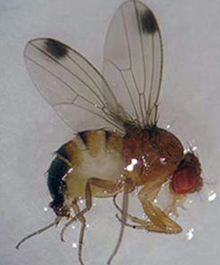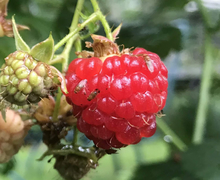Key points
- Know which insect pests are more important, and monitor for them in order to know when to implement control measures.
- Tarnished plant bug (TPB) and spotted wing Drosophila (SWD) and the two most significant insect pests for strawberries in Minnesota.
- Numerous resources are available on TPB and SWD from UMN Extension and other universities.
- Encouraging beneficial insects can sometimes help keep pest populations in check.
High-frequency insect pests
You will likely need to deal with these pests every year and should take active preventative measures.
- Tarnished plant bug (Lygus lineolaris)
- Spotted wing drosophila (Drosophila suzukii) - most relevant for day-neutral strawberries
Medium-frequency insect pests
These pests will only show up on occasion. Watch for signs of them, so you can catch them early.
- Cyclamen mites
- Japanese beetle (Popillia japonica)
- Slugs
- Strawberry bud weevil (Anthonomus signatus)
- Two-spotted spider mite (Tetranychus urticae)
Low-frequency insect pests
You may see these pests only once or twice the entire time you grow strawberries.
- Eastern flower thrips (Frankliniella tritici)
- Picnic beetle and sap beetle
- Potato leafhopper
- Spittlebug
- White grubs (Phyllophaga spp.)
- Strawberry leafroller
Identifying and monitoring insect pests
The prerequisite to good pest management is understanding the major pest species and monitoring for them. Know how to identify the egg, larva, and adult stages of the top pest species, and know what their damage looks like.
Develop a schedule to scout regularly for pests and beneficial insects, especially at key points in the season when each pest causes damage.
To assess the activity of insect pests and beneficial insects, use sticky traps or visual plant samples. Most flying insects are attracted to the yellow or blue color of sticky traps. These traps are sheets coated on both sides with a sticky non-toxic compound. Traps can be used for detecting the presence of arthropods or for mass trapping of pests such as aphids and thrips.
Tarnished plant bug (TPB)
- 1/16 to 1/4 inch long insects with brown, yellow, and black markings that feed on strawberry blossoms during bloom.
- Active from April to September.
- The injured blossoms continue to develop into berries, but the feeding damage causes a distinctive “cat face” deformity on the berries.
- This pest must be monitored closely and controlled right before or during bloom, before it initiates the blossom damage.
- Scouting: At several locations throughout the field, place a white sheet of paper under the strawberry canopy and shake the leaves to see if any TPB adults fall onto the paper.
Spotted wing drosophila (SWD)
- Invasive fruit fly that penetrates the skin of soft fruit to lay eggs.
- Larvae emerge from the eggs and feed on the flesh of the fruit, making it “mushy” and unmarketable.
- Since SWD becomes active in Minnesota in late June and populations peak in August, it is a more significant pest for day-neutral strawberries than June-bearing strawberries.
- Daily or every other-day harvest, immediately refrigerating fruit after harvest, and using select insecticides are several of the main control measures against SWD.
- Scouting: Use scented traps to monitor for SWD and know when it has arrived at your farm.
- Read more about SWD from UMN FruitEdge.
Beneficial insects and plant diversity
Your strawberry field is full of a wide variety of insects. Only a few of them are pests—some are beneficial, and some do not impact the crop either way.
Beneficial insects such as predators and parasites are important to preventing outbreaks of insect pest populations.
Plant diversity can encourage the presence of beneficial insects. To increase your plant diversity, you may want to use crop mixtures, crop rotations, border crops or windbreaks, or plants known to be attractive to beneficial insects.
More information on beneficial insects and the benefits of plant diversity can be found in the SARE publication, Manage Insects on Your Farm.
Integrated Pest Management Manual for Minnesota Strawberry Fields. Minnesota Department of Agriculture, 2007.
Midwest Fruit Pest Management Guide. Purdue University, 2021.
Reviewed in 2021






